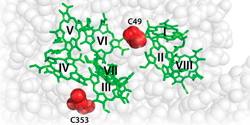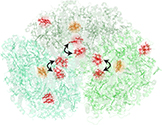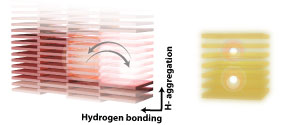Greg Engel Professor of Chemistry and Molecular Engineering

Greg Engel
Professor of Chemistry and Molecular Engineering at The University of Chicago
Miller Fellow, UC Berkeley 2005-2007
Ph.D., Harvard University, 2004
A.M., Harvard University, 2001
A.B., Princeton University, 1999
GCIS E119
929 East 57th Street
Chicago, IL 60637 USA
Chemistry Department Page
Biophysical Sciences Page
Molecular Engineering Page
gsengel@engelgroup.uchicago.edu
(773)-834-0818
Research
Research in the Engel Group focuses on excited state reactivity including excitonic transport, non-radiative relaxation to photochemical products, and new methods to image excited state dynamics. Excited states in the condensed phase have an extremely high chemical potential thereby making them highly reactive and difficult to control. Our control strategy involves exploiting coherent response of the environment to the excitation event. In particular, we develop methodologies to manipulate two fundamental components of excited state dynamics: exciton migration and non-radiative relaxation.
Our approach is inspired by biological systems optimized by evolution to exploit manifestly quantum mechanical phenomena to drive coherent energy transfer, to steer trajectories through conical intersections and to protect long-lived quantum coherence. Currently, we are focusing on four key scientific efforts: (1) new techniques to image excited state dynamics, (2) understanding mechanisms of quantum transport in photosynthesis, (3) dynamics of conical intersections in the condensed phase, and (4) engineering quantum dynamics in new classes of synthetic materials.
The Engel Group program explores the interface between biology and quantum mechanics by creating new tools to explore design principles of coherent processes in proteins. Photosynthetic light harvesting and photoenzymatic dynamics exploit coherent protein motions for chemical control in a way that we do not yet fully understand. For example, Photosynthetic antenna complexes operate with near perfect quantum efficiency and steer excitonic motion with exquisite precision. These complexes exploit both incoherent (Förster) energy transfer along with coherent (wavelike) motion of energy in a process called Environmentally Assisted Quantum Transport that offers quantum efficiency superior to either mechanism alone. The Engel group seeks to isolate and copy the microscopic details of this process. In particular, we want to know if the process is a result of evolutionary fine-tuning and, regardless, how we can enable coherent energy transfer in synthetic systems for light harvesting, sensing, and communications.
To probe these systems, we design new femtosecond spectrometers to observe how electronic states couple to one another much the way COSY NMR explores nuclear spin coupling. Exploiting this analogy, we recently developed the first optical analog to MRI for rapid detection electronic couplings. The Engel group is strongly interdisciplinary; graduate students matriculate through Chemistry and the Biophysical Sciences while postdoctoral scholars have PhDs in Chemistry or Physics. The group contains pure theorists, organic chemists, inorganic chemists, physical chemists, physicists, and biophysicists. Engel and his lab members collaborate with physicists, biologists, engineers, and corporate partners to develop new technologies and new science.
Life Outside the Laboratory
Greg enjoys spending time with his family, hiking in the Driftless region of Wisconsin, cross country skiing (he's not any good), and shooting.
Bio
Born: 9/23/1977, West Chester, PA, USA.
Princeton University, A.B., 1999
Harvard University, A.M., 2001
Harvard University, Ph.D., 2004
Harvard University, Postdoctoral Scholar, 2004-2005
University of California, Berkeley, Postdoctoral Fellow, 2005-2007
University of Chicago, Professor, 2007-
Accolades
- 2023 Fellow of the American Chemical Society
- 2019 Bernstein Lecturer, UCLA
- 2017 & 2018 World Economic Forum Young Scientist
- 2016-2017 Chair, ACS Physical Chemistry (PHYS) Division
- 2016 Vannevar Bush Fellow (DoD)
- 2014 DoD NSSEFF Award
- 2013 FACSS Innovation Award
- 2013 Defense Science Study Group Member for 2014-2015
- 2012 Llewellyn John and Harriet Manchester Quantrell Award for Undergraduate Teaching
- 2012 Dreyfus Teacher-Scholar Award
- 2012 Sloan Research Fellowship
- 2012 Coblentz Award
- 2010 DTRA Young Investigator Award
- 2010 DARPA Young Faculty Award
- 2009 PECASE Recipient
- 2009 Searle Scholar
- 2008 AFOSR Young Investigator Program
- 2007 Scientific American Top 50 Leaders in Research
- 2007 Camille and Henry Dreyfus New Faculty Award
- 2005-2007 Miller Research Fellow
- 2003-2004 EPA STAR Fellow
- 1999-2002 NSF Graduate Research Fellow
- 1994 Eagle Scout
Recent Papers from the Engel Group
B.C. Li,* K. Lin,* P.-J. Wu, A. Gupta, K. Peng, S. Sohoni, J.C. Ondry, Z. Zhou, C.C. Bellora, Y.J. Ryu, S. Chariton, D.J. Gosztola, V.B. Prakapenka, R.D. Schaller, D.V. Talapin, E. Rabani, G.S. Engel, "Exciton-phonon Coupling and Phonon-assisted Exciton Relaxation Dynamics in In1-xGaxP Quantum Dots", Nature Communications (accepted) 2025
* These authors contributed equally
B.C. Li, H. Cairney, Y. Jin, J. Park, S. Sohoni, L.T. Lloyd, Y.Liu, J.E. Jureller, Y.J. Ryu, S. Chariton, V.B. Prakapenka, R.D. Schaller, G. Galli, and G.S. Engel, "Connectivity-dependent Exciton-phonon Coupling in Cesium Bismuth Halide Quantum Dots", ACS Nano 19, 10359–10368 2025
H. Gestsson, C. Nation, J.S. Higgins, G.S. Engel, and A. Olaya-Castro , "Non-perturbative exciton transfer rate analysis of the Fenna-Matthews-Olson photosynthetic complex under reducing and oxidizing conditions", JCP 162, 114114 2025
S.H. Sohail, S. Sohoni, P.-C. Ting, L.R. Fantz, S.M. Abdulhadi, C. MacGregor-Chatwin, A. Hitchcock, C.N. Hunter, G.S. Engel, and S.C. Massey, "Functional Connectivity of Red Chlorophylls in Cyanobacterial Photosystem I Revealed by Fluence-Dependent Transient Absorption", J. Phys. Chem B 129, 3191–3197 2025
I. Ghosh, Q. Shen, P.-J. Wu, and G.S. Engel, "Vibronic Conical Intersection Trajectory Signatures in Wave Packet Coherences", JPCL 15, 12494-12500 2024
S. Sohoni,* P.-J. Wu,* Q. Shen, L.T. Lloyd, C. Macgregor-Chatwin, A. Hitchcock, and G.S. Engel, "Resonant Vibrational Enhancement of Downhill Energy Transfer in the C-Phycocyanin Chromophore Dimer", JPCL 15, 11569–11576 2024
* These authors contributed equally
P.-J. Wu,* S. Sohoni,* and G.S. Engel, "Vibrational Relaxation Completes the Excitation Energy Transfer and Localization of Vibronic Excitons in Allophycocyanin α84 - β84", JPCL 15, 11577–11586 2024
* These authors contributed equally
S. Sohoni,* I. Ghosh,* G.T. Nash, C.A. Jones, L.T. Lloyd, B.C. Li, K.L. Ji, Z. Wang, W. Lin, and G.S. Engel, "Optically accessible long-lived electronic biexcitons at room temperature in strongly coupled H- aggregates", Nat. Comm. 15, 8280 2024.
* These authors contributed equally
W. Zhen, D.W. Kang, Y. Fan, Z. Wang, T. Germanas, G.T. Nash, Q. Shen, R. Leech, J. Li, G.S. Engel, R.R. Weichselbaum, and W. Lin, "Simultaneous Protonation and Metalation of a Porphyrin Covalent Organic Framework Enhance Photodynamic Therapy", JACS 146, 16609–16618 2024
E. Fresch, F.V.A. Camargo, Q. Shen, C.C. Bellora, T. Pullerits, G.S. Engel, G. Cerullo, and E. Collini, "Two-dimensional electronic spectroscopy", Nature Reviews Methods Primers 3 84 2023.
Recent News from the Engel Group
Paper Accepted 3/1/2025
Congratulations to Coco Li, Hugh Cairney, Sid Sohoni, Lawson Lloyd, and our collaborators in the Galli and Schaller groups on having their paper entitled, "Connectivity-dependent Exciton-phonon Coupling in Cesium Bismuth Halide Quantum Dot" accepted to ACS Nano
Paper Published 12/13/2024
Congratulations to Indranil Ghosh, Qijie Shen, and Eric Wu on having their paper entitled, "Vibronic Conical Intersection Trajectory Signatures in Wave Packet Coherences" published in JPCL.
Paper Accepted 10/17/2024
Congratulations to Sid Sohoni, Eric Wu, Qijie Shen, Lawson Lloyd and our collaborators on having their paper entitled, "Resonant Vibrational Enhancement of Downhill Energy Transfer in the C-Phycocyanin Chromophore Dimer" accepted at JPCL.
Paper Accepted 10/17/2024
Congratulations to Eric Wu and Sid Sohoni on having their paper entitled, "Vibrational Relaxation Completes the Excitation Energy Transfer and Localization of Vibronic Excitons in Allophycocyanin α84 - β84" accepted at JPCL.
Paper Published 9/27/2024
Congratulations to Sid Sohoni, Indranil Ghosh, Claire Jones, Lawson Lloyd, Coco Li, Karen Ji, and our collaborators in the Lin Group on having their paper entitled "Optically accessible long-lived electronic biexcitons at room temperature in strongly coupled H- aggregates" published in Nature Communications.
Paper Published 6/5/2024
Congratulations to Qijie Shen, Rachel Leech, and our collaborators in Wenbin Lin's group on their paper entitled "Simultaneous Protonation and Metalation of a Porphyrin Covalent Organic Framework Enhance Photodynamic Therapy" publishing in JACS.
Paper Published 11/9/2023
Congratulations to Qijie Shen and Caitlin Bellora and our collaborators on having their paper entitled "Two dimensional electronic spectroscopy" published in Nature Methods Primers.
Paper Accepted 9/14/2023
Congratulations to Indranil Ghosh, Olivia Wedig, Jake Higgins and our collaborators in the Mazziotti Group on having their paper entitled "Quantum sensing using multi-qubit quantum systems and the Pauli polytope" accepted at Physical Review Research.
Fellow of the American Chemical Society 8/14/2023
Greg Engel was honored at the ACS National Meeting and inducted as an ACS Fellow.
Fellow of the American Chemical Society 7/31/2023
Greg Engel has been named a Fellow of the American Chemical Society.






















